0564 Chapter Five, the second to last chapter, is titled, “Human Morality as Cooperation-Plus”
Cooperation-Plus?
Makes me wonder what is cooking.
0565 Two evolutionary steps occur.
The first corresponds to a transition from individual foraging in bands in tropical forests to obligate collaborative foraging in mixed forest and savannah.
The second corresponds to what happens when more and more teams become successful after the domestication of fire.
0566 Here is a list of three eras and two steps.
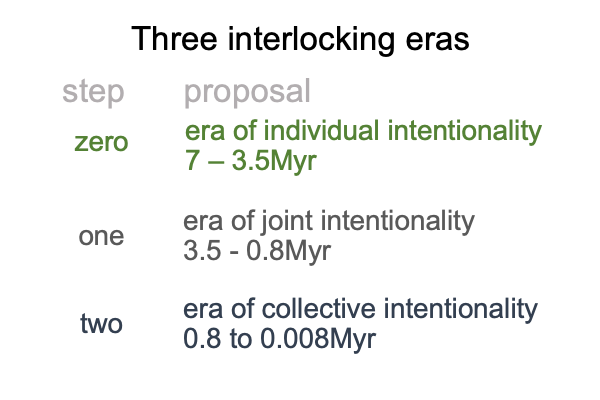
0567 Tomasello writes in our current Lebenswelt about the Lebenswelt that we evolved in. Tomasello proposes explicit abstractions to account for developments in a living world of implicit abstractions. An evolutionary anthropologist may understand his terminology, but an ancestor would stand befuddled. What do these technical terms picture or point to?
0568 The advantage of Peircean diagrams over the specialized terminology of evolutionary anthropology is clear.
The category-based nested form has three elements: normal context, actuality and potential. A spoken word is an actuality2. In the normal context of definition3 this actuality emerges from (and situates) three potentials: meaning, presence and message, corresponding to Peirce’s categories of thirdness, secondness and firstness, respectively. This is the proposition underlying the masterwork, How To Define The Word “Religion”, by Razie Mah, available at smashwords and other e-book venues.
Diagrams provide a presence1 that definitions3 of technical terms2 in evolutionary anthropology currently presume to be present.
0569 For example, what does the term, “caramelization”, presume to be present?
One needs to have a recipe in hand to know. Each category-based diagram follows a recipe.
The results are delicious.
0570 Our current Lebenswelt, full of spoken words and explicit abstractions, is not the same as the Lebenswelt that we evolved in, full of hand-talk, hand-speech talk and implicit abstractions.
0571 So, I summarize by visualizing how our current Lebenswelt views the intersection of the group for each era of intentionality.
0572 Here is the intersection for the zeroth era.
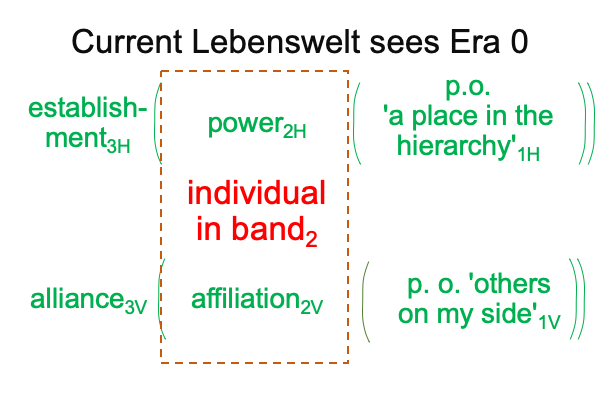
The band2 is necessary for protection against predators. Individuals compete within this constraint. They compete for establishment power, that is, a place in their hierarchies. They compete for alliances, affiliations where others are on my side.
Here is a world without justice and without fairness.
Or maybe, “justice” is me having a place in a hierarchy and “fairness” is me having others on my side.
0573 Next is the intersection for the first era.
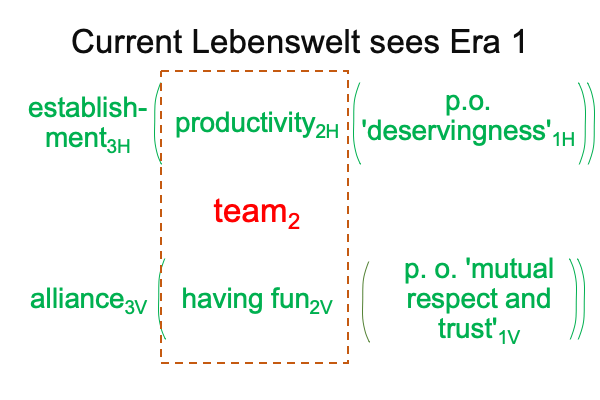
The team2 is the vehicle for collaborative foraging. Collaborative foraging is unavoidable, because each individual cannot successfully forage the foods that other species either ignore or cannot get to. Teams are required.
Successful teams are productive. Everyone in a successful team gets along with everyone else. How do I know this? The team is having fun.
Of course, the ambiguous term, “having fun”, does not crop up in the vocabulary of evolutionary anthropologists. Perhaps, it should. Another word might be “camaraderie”.
0574 Next is an intersection for the second era.
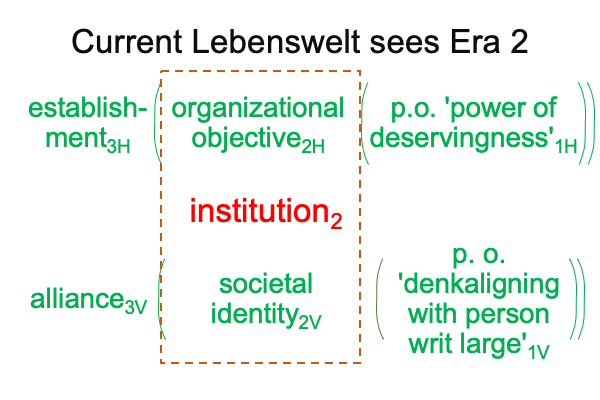
0575 One irony is that the term, “establishment3H“, cannot be stated in hand-talk or hand-speech talk. Neither can the word, “institution3H“. Plus, the term, “social circle3H“, seems inadequate, since there is a third person that is conjured in each manifestation of a social circle.
An institution is a individual writ large.
For example, the community (150) contains several bands (50), many teams (15) and many many families (5) and deep friendships (5). Also, the community (150) is contained within mega-bands (450) that meet according to seasons and tribes (1500) that meet either according to the stars or by the bidding of messengers.
Each manifestation of a social circle2 feels like a person writ large, that is, someoneC who interpellates individualsA to come into organizationB. IndividualsA enjoy societal identityC. OrganizationsB pursue their objectivesC. The successes and the failures of those pursuitsB empower individualsA who are deserving and disempower individualsA who are less so.
0575 But, that is not enough.
Once again, here is an intersection for the second era.
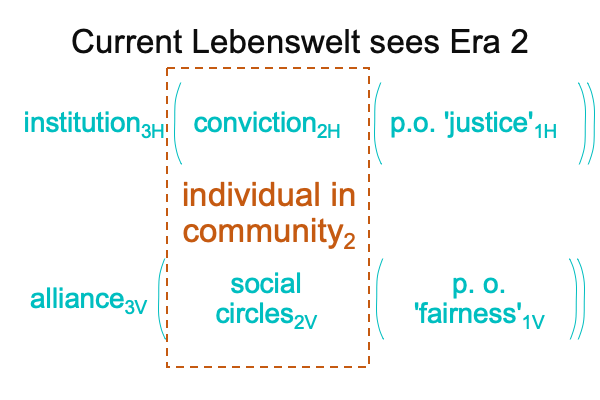
0576 Here, the individual in community2 is a single actuality constituted by suprasubjective judgments2H and social circles2V. Conviction2H emerges from and situates the potential of something more than deservingness1H in the normal context of establishment3H. Social circles2V emerge from and situate the potential of something more than mutual respect and trust1V in the normal context of alliance3V.
An individual in community is an institution writ small.
0577 Given the prior four figures, the inquirer can trace the presence of the philosophical terms, “justice1H” and “fairness1H” backwards through human evolution, to the LCA. The exercise is well worth the effort.
